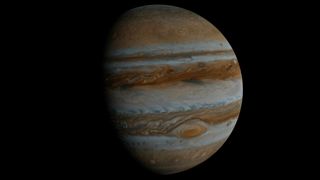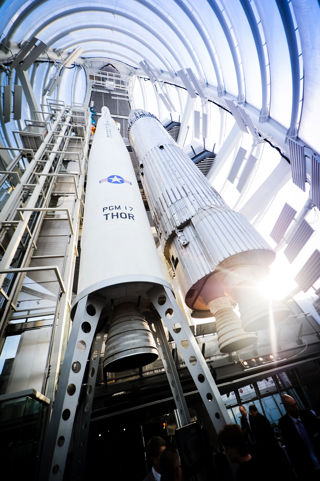
What's Happening in Space: November 2023
- 2nd Nov 2023

Dhara Patel is a Space Expert at the National Space Centre, working to help share space science, stories, and topical news with our visitors and online audiences. Each month she curates a round-up of some notable space and science events coming up the weeks ahead.
Use these to inspire your own star-gazing or to get students talking about the busy and exciting space happenings around the world!
1st November – Lucy mission: first asteroid flyby
Launched in 2021, NASA’s Lucy spacecraft will fly-by its first asteroid target - the small Main Belt asteroid Dinkinesh. The encounter on 1st November will allow scientists to test its instruments in preparation for visits to multiple Trojan asteroids in the coming years. The main aim of the Lucy mission is to study the Jupiter Trojan asteroids which circle the Sun in the same orbit as Jupiter. This never-before-explored group of small space rocks orbit in two “swarms” that lead and follow Jupiter in its orbit. Asteroid Dinkinesh was added to Lucy’s list of targets at the start of this year and over its 12-year mission duration it will be the first of 10 asteroids that Lucy will visit. In 2025, before Lucy gets to the Trojans, it will fly by Donaldjohanson (another main belt asteroid) to allow additional tests of the spacecraft’s procedures and systems.
2nd November – Galactic 05 mission launch
Set to become Virgin Galactic’s sixth flight in six months, Richard Branson’s spaceflight company will fly its fifth commercial suborbital mission from the world's first purpose-built commercial spaceport - Spaceport America in New Mexico. The flight will reach an altitude of about 87km. There will be three passengers aboard this research flight on the VSS Unity spaceplane - including an unnamed private astronaut of Franco-Italian nationality; planetary scientist Alan Stern (the principal investigator of NASA's New Horizons Pluto mission), and Kellie Gerardi - a science communicator and bioastronautics researcher for the International Institute for Astronautical Sciences (IIAS). The launch window opens on 2nd November.

3rd November – Jupiter at opposition
Because Earth and Jupiter have different orbits and orbital speeds, the distance between them is constantly changing. On 3rd November, appearing in the constellation of Aries, Jupiter will be on the opposite side of the Earth compared to the Sun so it will be at its closest approach to Earth and its face will be fully illuminated by the Sun. The Sun, Earth, and Jupiter will be in ‘syzygy’ or a roughly straight-line configuration. At the time of opposition, Jupiter will be brighter than at any other time of the year and will be visible all night long making it the best time to view and photograph the planet. A medium-sized telescope should be able to show you some of the details in Jupiter's cloud bands. A good pair of binoculars should allow you to see Jupiter's four largest moons, appearing as bright dots on either side of the planet. The ideal time to look is around midnight when it will appear in the south, but you can look out for it from late evening on 3rd November to the early morning of 4th November. Find out more about oppositions and other astronomical phenomena in our blog written by David Southworth in our Education Team: Astronomical phenomena (spacecentre.co.uk).
9th November – close approach / conjunction of the Moon and Venus
During the morning of 9th November, the extremely thin crescent moon will be in conjunction (sharing the same right ascension – coordinate) with Venus. Whilst they’ll both be above the horizon, they’ll be hard to spot in the daylight. Instead look for the pair a little earlier, in the hours just before sunrise – they’ll be in close approach of one and other and will be up in the south-east. It would help to try to find a clear observing location without tall buildings/trees that may usually block your view. They’ll be visible to the naked eye and could be seen together through a pair of binoculars but will be too far separated to be seen within the field of view of a telescope. Check out the astronomical phenomena blog above to find out more about conjunctions and other astronomical phenomena.
11th/12th November – peak of the Northern Taurid meteor shower
The Taurid meteor shower is composed of two streams: The Southern Taurids which peak between 4th and 5th November and the Northern Taurids which peak between 11th and 12th November.
It’s a weaker shower with 5-10 meteors per hour at its peak, produced by dust left behind by the small comet Encke. The Taurids don’t have very definite peaks and instead ramble along in October and November and are especially noticeable from late October into early November when they overlap. Best viewing will be from a dark location after midnight on the 11th into the early hours of the 12th . Meteors will radiate from the constellation of Taurus (in the south around midnight) but can appear anywhere in the sky. The waning crescent moon will be below the horizon through the night, so moonlight interference shouldn’t be a problem. The Taurids are rich in fireballs (particularly bright meteors) but their rate is low. When Taurids appear, they’re big and bright but you’re likely to only see a few meteors per hour – still, it’s well worth a watch but you’ll need patience. A blog about the Taurid meteor shower 2023 will soon be up on our website: https://www.spacecentre.co.uk/news/space-now-blog/
13th November – new moon (9:27am)
The new moon on 13th will occur in the constellation of Libra. We have a blog on ‘phases of the moon’ written by Mike Darch in our Space Comms team: What are the Phases of the Moon? (spacecentre.co.uk).
13th November – Uranus at opposition
Because Earth and Uranus have different orbits and orbital speeds, the distance between them is constantly changing. On 13th November, appearing in the constellation of Aries, Uranus will be on the opposite side of the Earth compared to the Sun so it will be at its closest approach to Earth and its face will be fully illuminated by the Sun. The Sun, Earth, and Uranus will be in ‘syzygy’ or a roughly straight-line configuration. At the time of opposition, Uranus will be brighter than at any other time of the year and will be visible all night long making it the best time to view and photograph the planet. It will appear as a tiny blue-green dot due to its distance in all but the largest telescopes. Look from late evening on 13th November to the early morning of 14th November – ideally look towards the south around midnight.
17th/18th November – peak of the Leonid meteor shower
A minor shower, ~ 10 meteors per hour at its peak, produced by dust left behind by Comet Tempel-Tuttle. The meteors will radiate from the constellation of Leo (rising above the eastern horizon after midnight) but can appear anywhere in the sky. Peaking on the night of the 17th and into the morning of the 18th, the waning crescent moon will be below the horizon throughout the night so there should be no moonlight interference to block out the fainter meteors this year. If viewing is done from a dark location, it may be possible to catch a few meteors during this minor shower. The radiant will continue to rise higher into the sky during the early morning of the 18th, so it might be best to head out after midnight and look until just before sunrise when the radiant will be in the south-east. Occasionally, the display turns sublime: every 33 years or so, there have been instances of the Leonids producing meteors at a rate of about 1,000 — or more — in an hour! However, this won't happen again until 2034. A blog about the Leonid meteor shower 2023 will soon be up on our website: https://www.spacecentre.co.uk/news/space-now-blog/
20th November – close approach / conjunction of the Moon and Saturn
On the afternoon of 20th November, the waxing gibbous moon will be in conjunction (sharing the same right ascension – coordinate) with Saturn. At the time of conjunction, the moon will just be rising above the horizon and Saturn will be lost in the glare of daylight. So instead look for the pair in the southern sky that evening as the sun begins to set until around 11:00pm when they’ll fall out of view in the west. They should be high enough above the horizon to spot but it’s always helpful to have a clear view of the horizon without tall buildings and trees to view them easily. They’ll be visible to the naked eye and through a pair of binoculars but too far separated to be seen within the field of view of a telescope. Check out the astronomical phenomena blog above to find out more about conjunctions and other astronomical phenomena.
25th November – close approach / conjunction of the Moon and Jupiter
During the morning of 25th November, the waxing gibbous moon will be in conjunction (sharing the same right ascension – coordinate) with Jupiter. At the time of conjunction (roughly 11:00am), the pair will be below the horizon. Instead you can catch the pair in close approach during the very early hours of the 25th – look to the west around 2:00/3:00am – the pair will be quite close to the horizon so try and find a clear view, unobstructed by trees and buildings, if you can. If you’re not an early riser or don’t fancy staying up so late, you can also catch the pair in close approach in the east after the sun sets later that day (they’ll be a little more separated then). You won’t be able to see them both in the same field of view of a telescope and may struggle with a pair of binoculars too, but you’ll easily be able to spot them with the naked eye if the weather plays ball. Check out the astronomical phenomena blog above to find out more about conjunctions and other astronomical phenomena.
27th November – full moon (9:16am)
Known as the Beaver moon (according to the old Farmers’ Almanac), it marks the time of year when people would set beaver traps, or when beavers became very active building dams, getting ready for winter. Check out the “Full Moon: Full Facts” blog written by Mike Darch in our Space Comms team: Full Moons and Full Facts (spacecentre.co.uk).

November – Starship next test flight?
Following the first test flight of the fully integrated Starship rocket on 20th April 2023, SpaceX have been working on numerous design changes and are readying for a second attempt. Starship is made of the Super Heavy booster – a first stage rocket with 33 of SpaceX’s raptor engines and on top of that sits the upper stage, rather confusingly also called Starship, which hosts 6 engines. When it's fully developed it will be a completely reusable rocket – both first and second stages. Back in April the upper stage failed to separate from the booster a few minutes into its first flight and SpaceX experienced a ‘rapid unscheduled disassembly’ a.k.a. an explosion. The FAA report indicated over 60 corrective actions that needed to be made – almost half of which were related to public safety. Working with SpaceX, the FAA commented to say the modified licence that would allow Starship to launch again could be ready by mid to end of October. But a separate environmental review is needed to examine changes to launch site infrastructure, including a water deluge system intended to minimize pad damage suffered in the April launch. The FAA are hopeful that it will wrap up somewhere in proximity to the safety review. Elon Musk said recently that SpaceX has actioned all of the corrective measures required ahead of flight number two, but the U.S. Federal Aviation Administration (FAA) has not yet granted a license for the upcoming flight. Find out more about Starship and SpaceX’s other rocketry achievements in this blog by Ed Turner in our Education team: https://www.spacecentre.co.uk/news/space-now-blog/spacex-the-world-s-rocket-giant/
Please note: As this summary is created at the end of the month before, dates (especially launch dates) can often change or be updated, so this content may become outdated - we always recommend checking on the relevant organisation's pages.
